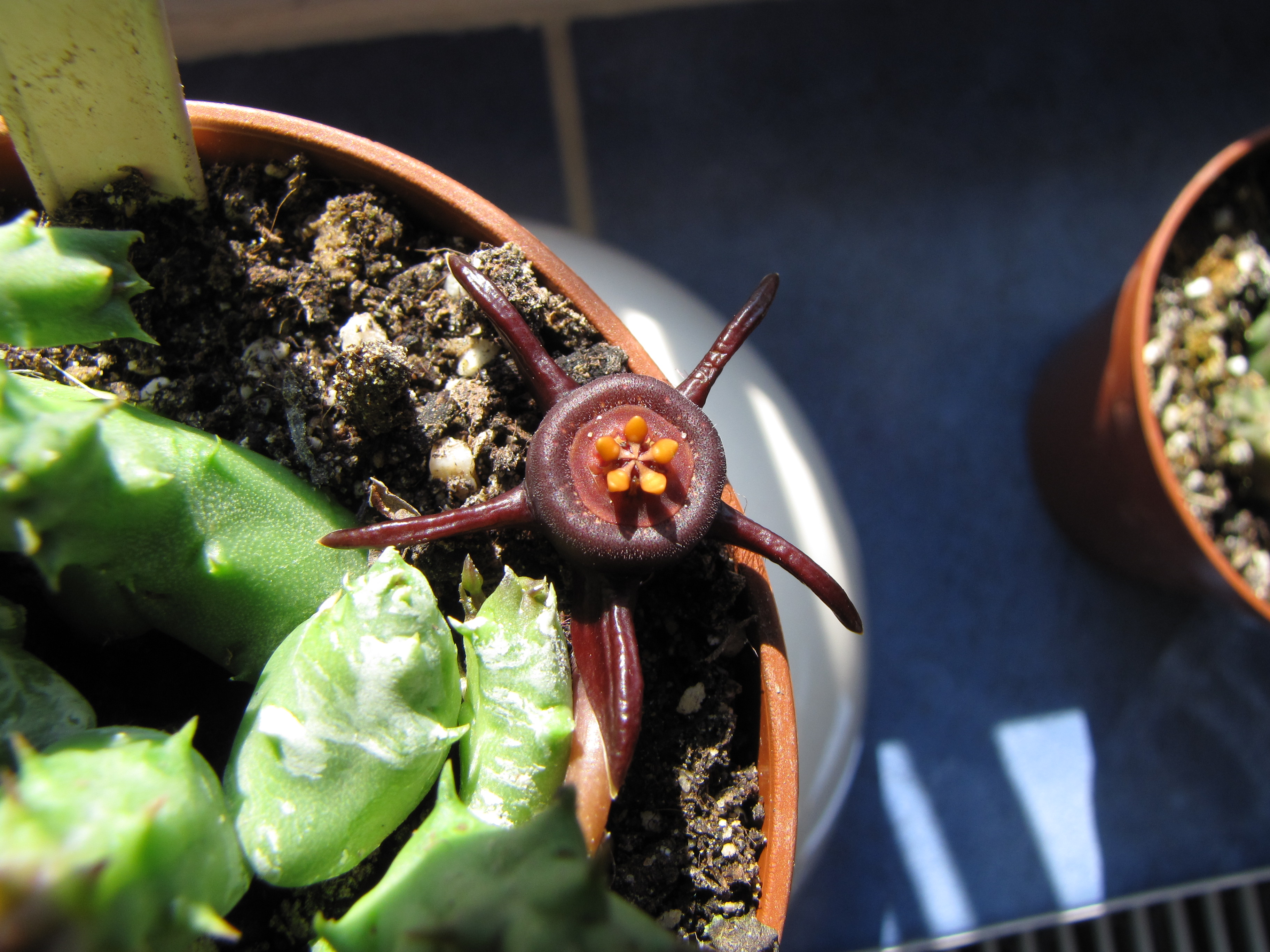Duvalia on:
[Wikipedia]
[Google]
[Amazon]
''Duvalia'' is a succulent plant genus in the subfamily




/ref> ;formerly included transferred to '' Mannia'' *''Duvalia rupestris'' now '' Mannia rupestris''
Asclepiadoideae
The Asclepiadoideae are a subfamily of plants in the family Apocynaceae. Formerly, it was treated as a separate family under the name Asclepiadaceae, e.g. by APG II, and known as the milkweed family.
They form a group of perennial herbs, twinin ...
, in the family Apocynaceae
Apocynaceae (, from '' Apocynum'', Greek for "dog-away") is a family of flowering plants that includes trees, shrubs, herbs, stem succulents, and vines, commonly known as the dogbane family, because some taxa were used as dog poison. Notable mem ...
(dogbane).
The genus was first described in 1812, named after the French physician and botanist Henri-Auguste Duval (1777-1814).
Description




Vegetative
The ''Duvalia'' species are succulent, perennial plants with low, planar growth. The stems are clavate, cylindrical to spherical, in cross-section four-, five-or six-edged, and to about 10 inches long. They can range from green, gray to mottled reddish in color. The stems of some species, such as the rounded '' Duvalia parviflora'', are distinctive, and these species can be identified even when not in flower. However the stems are very variable, and most ''Duvalia'' species can only be distinguished from each other when the flower is seen. The stems are superficially very similar to those of the related genus ''Piaranthus
''Piaranthus'' is a succulent plant genus in the subfamily Asclepiadoideae, in the family Apocynaceae.
It was first described in 1810. Its name comes from Greek and is descriptive of the fleshy, succulent flowers typical of the genus (''"piar-" ...
'', and the two are often confused when not in flower. In cross-section, ''Duvalia'' stems are sometimes five or six sided (''Piaranthus
''Piaranthus'' is a succulent plant genus in the subfamily Asclepiadoideae, in the family Apocynaceae.
It was first described in 1810. Its name comes from Greek and is descriptive of the fleshy, succulent flowers typical of the genus (''"piar-" ...
'' stems are always four-sided in cross-section). To accurately distinguish them however, it is necessary to examine the flowers.
Floral
The distinctive flowers are on long, bare stalks, which grow from the base of the stems. Each flower has five thin, elongated petal-like lobes, radiating in a star-shape, from a central raised disk or annulus. The colour of most species flowers is shades of reddish brown, except for those of the rare '' Duvalia parviflora'' which are cream-coloured. The hermaphroditic flowers measure 1–5 cm in diameter, and have five parts. The crown is yellow ocher, brown, red to dark purple. The five corolla lobes are flat or folded along the middle nerve.Distribution
It occurs insouthern Africa
Southern Africa is the southernmost region of Africa. No definition is agreed upon, but some groupings include the United Nations geoscheme for Africa, United Nations geoscheme, the intergovernmental Southern African Development Community, and ...
. The majority of the species are restricted to the western part of South Africa
South Africa, officially the Republic of South Africa (RSA), is the Southern Africa, southernmost country in Africa. Its Provinces of South Africa, nine provinces are bounded to the south by of coastline that stretches along the Atlantic O ...
& Namibia
Namibia, officially the Republic of Namibia, is a country on the west coast of Southern Africa. Its borders include the Atlantic Ocean to the west, Angola and Zambia to the north, Botswana to the east and South Africa to the south; in the no ...
, with the greatest number of species occurring in the Great Karoo
The Karoo ( ; from the Afrikaans borrowing of the South Khoekhoe Khoemana (also known as !Orakobab or Korana) word is a semidesert natural region of South Africa. No exact definition of what constitutes the Karoo is available, so its extent i ...
region, on the edge of the winter rainfall area.
Only one species, ''Duvalia polita
''Duvalia'' is a succulent plant genus in the subfamily Asclepiadoideae, in the family Apocynaceae (dogbane).
The genus was first described in 1812, named after the French physician and botanist Henri-Auguste Duval (1777-1814).
Description
...
'' extends further east, and as far north into tropical Africa as Malawi
Malawi, officially the Republic of Malawi, is a landlocked country in Southeastern Africa. It is bordered by Zambia to the west, Tanzania to the north and northeast, and Mozambique to the east, south, and southwest. Malawi spans over and ...
and Zambia
Zambia, officially the Republic of Zambia, is a landlocked country at the crossroads of Central Africa, Central, Southern Africa, Southern and East Africa. It is typically referred to being in South-Central Africa or Southern Africa. It is bor ...
.
Four species, occurring on the other side of the continent on the verges of the Red Sea
The Red Sea is a sea inlet of the Indian Ocean, lying between Africa and Asia. Its connection to the ocean is in the south, through the Bab-el-Mandeb Strait and the Gulf of Aden. To its north lie the Sinai Peninsula, the Gulf of Aqaba, and th ...
, were formerly included in the genus ''Duvalia''. However phylogenetic studies have shown them to be relatively unrelated to the rest of the genus, and more closely related to genus ''Ballyanthus
''Ballyanthus'' is a genus of flowering plants belonging to the family Apocynaceae
Apocynaceae (, from '' Apocynum'', Greek for "dog-away") is a family of flowering plants that includes trees, shrubs, herbs, stem succulents, and vines, common ...
'' Bruyns.P. Bruyns, C. Klak, P. Hanacek: ''Evolution of the stapeliads (Apocynaceae-Asclepiadoideae) - repeated major radiation across Africa in an Old World group. Molecular Phylogenetics and Evolution.'' 2014. v. 77, no. 1, p. 251--263. ISSN 1055-7903.
;SpeciesThe Plant List, ''Duvalia''/ref> ;formerly included transferred to '' Mannia'' *''Duvalia rupestris'' now '' Mannia rupestris''
References
''Portions of this page were translated from the equivalent page on the German wikipedia accessed July 3, 2012'' {{Authority control Apocynaceae genera